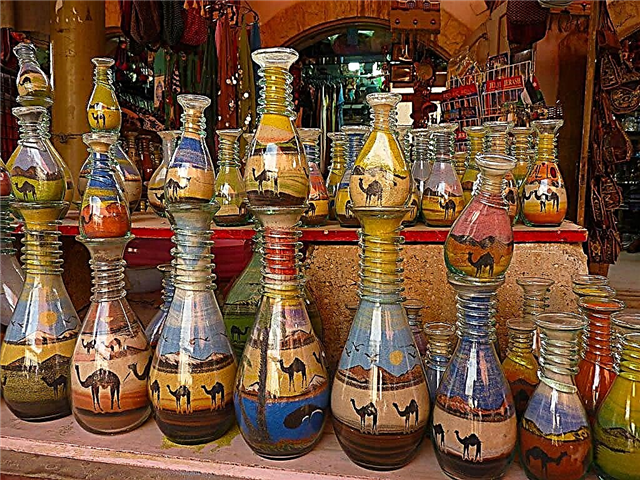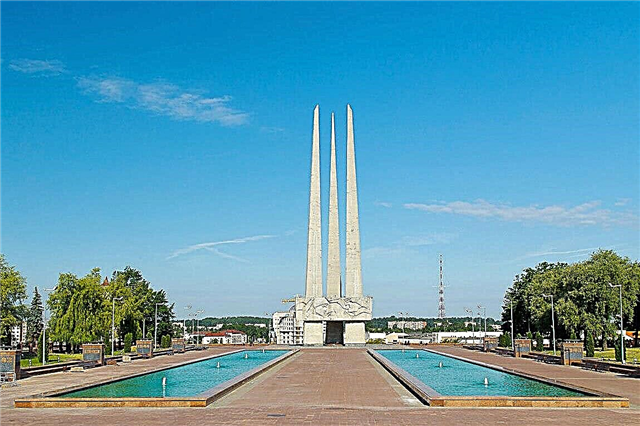Vitebsk is one of the most ancient cities of Belarus and all of Eastern Europe, founded at the end of the 10th century. In the era of fragmentation, Vitebsk was one of the cities that fought for power in the region. In the Middle Ages, it crossed several times between the Rzeczpospolita and Russia, but by the 18th century Vitebsk and the surrounding territories were finally entrenched in the Russian Empire until the 20th century.
The Second World War affected Vitebsk, as well as many other cities. And the foundation of the city's industry was laid in the post-war period, which made it one of the centers of mechanical engineering and metalworking in Belarus. Despite the fact that not too many tourists visit Vitebsk, there are many interesting monuments in the city. They reflect the rich history of the ancient city and its outstanding natives.
Historical and modern monuments of Vitebsk
List, photo with names and descriptions of popular monuments in the city.
"Three bayonets"
The main monument of Vitebsk, located on Victory Square, was erected in 1974. The memorial is dedicated to the liberators of Vitebsk in the Second World War. Its main part is three obelisks, 56 meters high. They symbolize Soviet soldiers, partisans and underground fighters who liberated the city. A path leads to the obelisk between the pools with fountains. Nearby are sculptures of civilians and soldiers, and an eternal flame is lit at the foot of the obelisk.

Monument to Prince Olgerd
In the middle of the XIV century, thanks to the conclusion of a dynastic marriage, Vitebsk became part of the Grand Duchy of Lithuania. It was in the XIV and XV centuries that the city's development flourished. Stone city walls and several Orthodox churches were built. The height of the largest equestrian monument in Belarus is more than 5 meters. The figure of Olgerd, with a falcon on his hand, leaving the Vitebsk castle, was installed in honor of the 1040th anniversary of the city.

Monument to A. Ya. Nevsky
Prince Alexander Nevsky, canonized by the Orthodox Church, contributed to the rapprochement of the Novgorod land and the Vitebsk principality. In the middle of the XIII century, he married the daughter of the Vitebsk prince, and in 1245 he came for his wife and son. It is this moment that is captured in the monument. Bronze figures of Alexander Nevsky and Princess Alexandra with her son, about 4 meters high, were installed on Millennium Square in 2016.

Monument to V.I.Lenin
The Vitebsk monument is one of the first in the USSR dedicated to Vladimir Lenin. It was installed in 1930, but during the Second World War, the city was captured, and the monument was destroyed. The new monument, with a total height of more than 9 meters, was erected by the city authorities in 1956. Lenin holds a cap in one hand, and stretches the other forward, preparing for the upcoming solemn speech.

"Vitebsk giant"
The tallest man in the world, Fyodor Makhnov, was born in a village near Vitebsk in 1878. Different sources indicate different heights - from 239 to 285 centimeters. Fedor performed in a circus and traveled with him to European countries. Fedor died at the age of 34. The bronze sculpture, more than 3 meters high, was installed 140 years after the birth of Fedor, in 2018.

Monument to V.S.Korotkevich
One of the most famous writers and screenwriters of Belarus of the XX century, Vladimir Korotkevich, was born in Orsha, in 1930. A monument dedicated to him was erected in the Vitebsk park in 1994. On a stone pedestal there is a bronze bust of a writer wrapped in a cloak. Near him every year, in November, literary festivals and meetings dedicated to Korotkevich are held.

"Gold fish"
A bronze sculpture, about one and a half meters high, was installed at the mouth of the Vitba River. The author of the monument is Ivan Kazak. The fish holds the key to the city in its mouth. The artistic purpose of the sculpture or its symbolism remains a mystery. Perhaps the monument is dedicated to the heroes of the fairy tales of Alexander Pushkin, who in the 19th century passed through Vitebsk and stopped here.

"Old Man Hottabych"
Simultaneously with the Golden Fish, a monument to old man Hottabych was erected on the day of the city. The sculpture is located next to the city puppet theater "Lyalka". The bronze statue depicts a fabulous genie holding a man with a camel in his palms. The monument to the fairytale hero was placed in Vitebsk for a reason. It was here in 1903 that Lazar Lagin was born, who wrote the fairy tale "Old Man Hottabych" under the pseudonym "Ginzburg".

Monument to P.M. Masherov
Peter Masherov was born in the territory of the modern Vitebsk region, in 1913. During the war, he organized a partisan movement, was wounded twice, and in 1944 was awarded the Star of the Hero of the Soviet Union. Since 1947, Masherov was appointed to the post of first secretary of the Central Committee of the Communist Party of Belarus. Under him, the republic reached a high level of development, the foundation of its modern economy was laid. A bronze bust of Masherov on a stone pedestal is installed next to the Yakub Kolas theater.

Monument to A. Pushkin
A monument to the great poet is erected on Pushkin Street. He stayed in Vitebsk twice - in 1820 and in 1824. According to one version, it was the story of a nobleman from Vitebsk that gave the idea and pushed Pushkin to write "Dubrovsky". The monument to the poet was erected not far from the Vitebsk puppet theater. The bronze figure of Pushkin, looking into the distance, against the background of the city's buildings, is installed on a pedestal with a commemorative plaque.

"Pain"
The monument is dedicated to the Belarusians who died during the war in Afghanistan. The sculpture depicts a kneeling woman and her deceased son. The soldier seems to be floating in the air, passing through the figure of his mother. There is a chapel next to the sculpture. Here everyone can light a candle in memory of the victims of the conflict in Afghanistan. Soon it is planned to set up a park around the monument.

Monument to Patriarch Alexy II
Patriarch Alexy II visited Belarus several times. In Vitebsk, he founded the Assumption Cathedral, which has survived to this day. The sculpture depicts Alexy II, calmly looking into the distance, in the traditional clothes of the patriarch. The height of the monument is over 5 meters. Despite the small stature of Alexy II, it was decided to create a tall and massive monument to show the spiritual strength and greatness of the patriarch. The sculpture is located near the Assumption Cathedral, once founded by Alexy II.

Monument to the Heroes of the Patriotic War of 1812
In honor of the centenary of victory in the war of 1812, a monument of the same name was erected in the park of heroes of the Patriotic War of 1812. The 26-meter obelisk is located on a stone pedestal. A bronze double-headed eagle is installed on its top. Near the monument there are cannons cast after the model of the 18th century. In July and October 1812 bloody battles were fought near Vitebsk. The memorial is dedicated to those who died in them.

Monument to Marc Chagall
All his childhood and youth Marc Chagall spent in Vitebsk. Despite the anti-Semitic sentiments that still persisted in the party authorities, the monument was nevertheless erected. The bronze sculpture depicts the great artist relaxing on a bench. The figure of a girl rises above his head. This is Bella Rosenfeld, the first wife and muse of Marc Chagall, with whom he was married for almost 30 years.

"Street Clown"
The sculpture was presented to Vitebsk by the Honored Artist of Russia, Nikolai Chelnokov. Another name for the monument is "The Wandering Musician". The sculpture depicts a cheerful clown with an accordion in his hands. A small poodle is sitting next to him. Many urban superstitions are associated with the monument. So, according to some of them, luck will accompany the one who greets the poodle by the paw.

"Meetings"
Bronze figures of people are installed on one of the railway platforms of the Vitebsk station.The sculpture depicts a couple - a girl with a flower in her hand and an adult man in a cylindrical hat, leaning on an umbrella and looking at his watch. Both are dressed in the fashion of the late 19th and early 20th centuries. The monument quickly became popular among the townspeople and guests of the city due to its unusualness and contrast with the modern city.

Monument-steam locomotive L-3562
The monument is located near the railway station, on the territory of the Vitebsk locomotive depot. The steam locomotive, installed as a monument, was produced in the post-war period. The main mystery associated with it is the disappearance from its front of the star with images of Stalin and Lenin. They were removed without explanation, and their further fate remains unknown.

"Children of War"
The monument was erected in the Park of Partisan Glory. The bronze sculpture depicts two children sitting in the ruins of a ruined house. The young man holds a small piece of bread in his hands. A girl, his sister, snuggles against him. During the Great Patriotic War, thousands of children were killed in concentration camps and during hostilities. Even more - orphaned or homeless.

Sculpture of San Crispino
The monument was erected in May 2011, at the suggestion of the city shoe enterprise "Marko". Saint Crispino is the patron saint of all shoemakers. He was born in the 3rd century in Rome, but together with his brother he left for Gaul, in the territory of modern France. There they started to repair and manufacture shoes. The brothers also preached Christianity, for which they were persecuted and executed. Later, the Catholic Church canonized them.

"Lucosa"
Not far from Vitebsk, there is a confluence of three rivers - Vitba, Western Dvina and Luchosa. The sculpture installed next to the hotel of the same name is dedicated to one of them. The monument consists of several large stones, on one of which sits the nymph, the patroness of the Lucosa River. Her figure is made of polymer material, despite the external resemblance to bronze.

The first Vitebsk tram
Vitebsk became one of the first cities in the Russian Empire, where tram transport was launched. The first tram was produced in Germany and began operation in 1898. The modern monument is an exact copy of it, recreated from photographs and drawings of the late 19th and early 20th centuries. The companies that created the first tramway met the city halfway and produced parts for the monument according to the original drawings from the archives.

Monument to the veterinarian
The monument was erected in the courtyard of the Vitebsk Veterinary Academy in 2011, in honor of the year of the Veterinary Service established by the UN. The monument is a bronze sculpture of a doctor surrounded by animals. A dog sits at his feet, a calf sits next to him, and a parrot sits on his hand. The monument was cast in Minsk, and funds for its installation were raised, among other things, thanks to voluntary donations.

Monument to Komsomol members of the underground
The Vitebsk underground was organized less than a month after the start of the Great Patriotic War. Until the liberation of the city in 1944, underground groups operated on its territory. In total, by 1944, more than 1,500 people were in their ranks. The monument is a monument, several meters high, which depicts the faces of soldiers, and a commemorative plaque is installed below.

Monument to I. Sollertinsky
Near the Sollertinsky College, a monument to the famous theater and musicologist is erected. A great music critic and an outstanding figure in the cultural circles not only of Leningrad, where he moved from Vitebsk, but of the whole country. Ivan Sollertinsky is a native of Vitebsk. He made a significant contribution to the development of art throughout the Soviet Union, becoming one of the most famous people in his native city.

"Aviators of the 339th VTAP"
The 339th Military Transport Aviation Regiment has been based at the Vitebsk airfield since 1947. Until 1996, the regiment's aviators participated in humanitarian missions around the globe. The last IL-76MD was redeployed from Vitebsk in 1996. The idea of installing the monument belongs to the regiment's veterans. A bronze figure of an IL-76 aircraft flying through the clouds is mounted on a stone stele.

Monument to the poetess Evdokia Los
The monument was erected in 1996, next to the city library named after Lenin. Evdokia Los was born in a village in the Vitebsk region. During her life, the poetess wrote many poems, including for children. Her works reflect her love for her native land. The theme of modern Vitebsk and its ancient history is the main one in the poetry and prose of Evdokia Los.

Monument to pilot A.K. Gorovets
The bronze bust of the Hero of the Soviet Union is located on the street named after him, where the parents of Alexander Horovets lived before the war. He took part in hostilities in the Caucasus and on the Voronezh front. During the departure, a group of pilots, including Gorovets, discovered a large number of German bombers. According to official data, Gorovets shot down 9 enemy vehicles in one battle. He is the only pilot in the USSR to achieve such a result in one battle.

Monument to soldiers-paratroopers
The sculpture is one of the youngest in Vitebsk. The author of the monument himself called it a small memorial complex. Bronze sculptures depict a vest and beret lying on a stone. Next to them is the figure of a soldier of the airborne troops, and in front of him is an opened parachute with the symbol of the Airborne Forces and images of the commanders of the 103rd Vitebsk airborne brigade.

Monument to the fire engine AC-40 (130) -63A
The main vehicle of Soviet firefighters, in use since the 1960s, was erected as a monument in the early 21st century. With this model, many fires have been extinguished and thousands of people have been saved. The monument is located next to the Ministry of Emergency Situations in the Vitebsk region and serves as a reminder of the huge number of feats performed by firefighters not only in Belarus, but throughout the Soviet Union.

Obelisk at the site of the 5th Regiment concentration camp
The Stalag 313 concentration camp was established near Vitebsk in 1941, where the 5th railway regiment was previously based. More than 80 thousand people were killed or died from diseases here. Most of them were civilians. In memory of the victims of the camp, a white memorial obelisk, several meters high, was erected in its place. And later, in 2005, an Orthodox cross, 15 meters high, was installed nearby.












